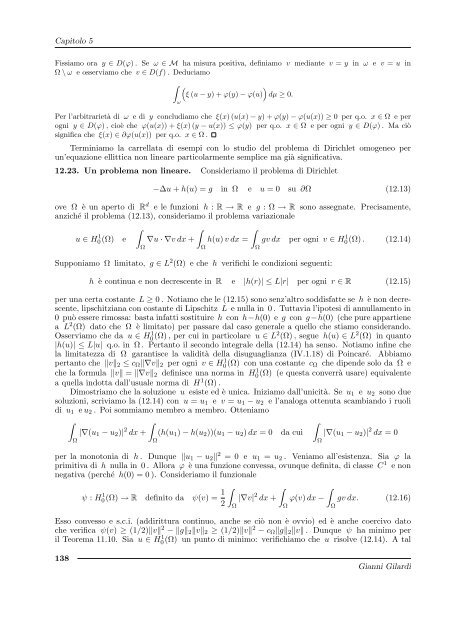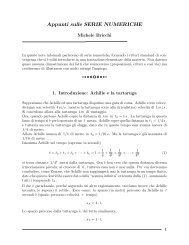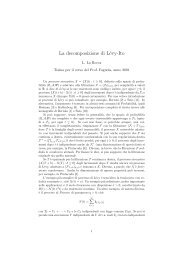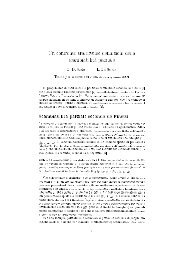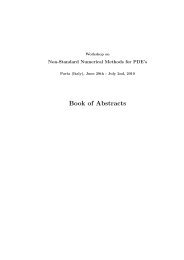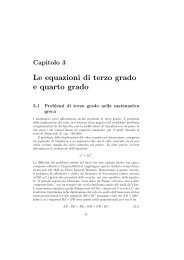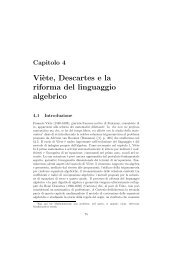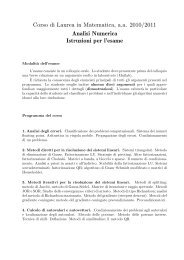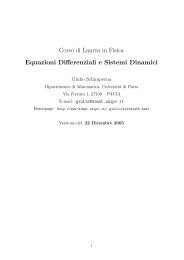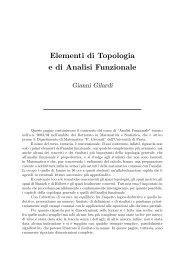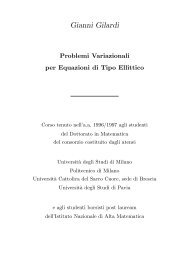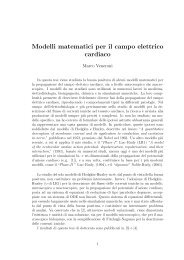G. Gilardi, Analisi Funzionale - Dipartimento di Matematica
G. Gilardi, Analisi Funzionale - Dipartimento di Matematica
G. Gilardi, Analisi Funzionale - Dipartimento di Matematica
Create successful ePaper yourself
Turn your PDF publications into a flip-book with our unique Google optimized e-Paper software.
Capitolo 5<br />
Fissiamo ora y ∈ D(ϕ) . Se ω ∈ M ha misura positiva, definiamo v me<strong>di</strong>ante v = y in ω e v = u in<br />
Ω \ ω e osserviamo che v ∈ D(f) . Deduciamo<br />
�<br />
ω<br />
�<br />
�<br />
ξ (u − y) + ϕ(y) − ϕ(u) dµ ≥ 0.<br />
Per l’arbitrarietà <strong>di</strong> ω e <strong>di</strong> y conclu<strong>di</strong>amo che ξ(x) (u(x) − y) + ϕ(y) − ϕ(u(x)) ≥ 0 per q.o. x ∈ Ω e per<br />
ogni y ∈ D(ϕ) , cioè che ϕ(u(x)) + ξ(x) (y − u(x)) ≤ ϕ(y) per q.o. x ∈ Ω e per ogni y ∈ D(ϕ) . Ma ciò<br />
significa che ξ(x) ∈ ∂ϕ(u(x)) per q.o. x ∈ Ω .<br />
Terminiamo la carrellata <strong>di</strong> esempi con lo stu<strong>di</strong>o del problema <strong>di</strong> Dirichlet omogeneo per<br />
un’equazione ellittica non lineare particolarmente semplice ma già significativa.<br />
12.23. Un problema non lineare. Consideriamo il problema <strong>di</strong> Dirichlet<br />
−∆u + h(u) = g in Ω e u = 0 su ∂Ω (12.13)<br />
ove Ω è un aperto <strong>di</strong> R d e le funzioni h : R → R e g : Ω → R sono assegnate. Precisamente,<br />
anziché il problema (12.13), consideriamo il problema variazionale<br />
u ∈ H 1 0 (Ω) e<br />
�<br />
Ω<br />
�<br />
�<br />
∇u · ∇v dx + h(u) v dx =<br />
Ω<br />
gv dx<br />
Ω<br />
per ogni v ∈ H1 0 (Ω) . (12.14)<br />
Supponiamo Ω limitato, g ∈ L 2 (Ω) e che h verifichi le con<strong>di</strong>zioni seguenti:<br />
h è continua e non decrescente in R e |h(r)| ≤ L|r| per ogni r ∈ R (12.15)<br />
per una certa costante L ≥ 0 . Notiamo che le (12.15) sono senz’altro sod<strong>di</strong>sfatte se h è non decrescente,<br />
lipschitziana con costante <strong>di</strong> Lipschitz L e nulla in 0 . Tuttavia l’ipotesi <strong>di</strong> annullamento in<br />
0 può essere rimossa: basta infatti sostituire h con h−h(0) e g con g−h(0) (che pure appartiene<br />
a L2 (Ω) dato che Ω è limitato) per passare dal caso generale a quello che stiamo considerando.<br />
Osserviamo che da u ∈ H1 0 (Ω) , per cui in particolare u ∈ L2 (Ω) , segue h(u) ∈ L2 (Ω) in quanto<br />
|h(u)| ≤ L|u| q.o. in Ω . Pertanto il secondo integrale della (12.14) ha senso. Notiamo infine che<br />
la limitatezza <strong>di</strong> Ω garantisce la vali<strong>di</strong>tà della <strong>di</strong>suguaglianza (IV.1.18) <strong>di</strong> Poincaré. Abbiamo<br />
pertanto che �v�2 ≤ cΩ�∇v�2 per ogni v ∈ H1 0 (Ω) con una costante cΩ che <strong>di</strong>pende solo da Ω e<br />
che la formula �v� = �∇v�2 definisce una norma in H 1 0<br />
(Ω) (e questa converrà usare) equivalente<br />
a quella indotta dall’usuale norma <strong>di</strong> H 1 (Ω) .<br />
Dimostriamo che la soluzione u esiste ed è unica. Iniziamo dall’unicità. Se u1 e u2 sono due<br />
soluzioni, scriviamo la (12.14) con u = u1 e v = u1 − u2 e l’analoga ottenuta scambiando i ruoli<br />
<strong>di</strong> u1 e u2 . Poi sommiamo membro a membro. Otteniamo<br />
�<br />
|∇(u1 − u2)|<br />
Ω<br />
2 dx +<br />
�<br />
Ω<br />
(h(u1) − h(u2))(u1 − u2) dx = 0 da cui<br />
�<br />
|∇(u1 − u2)|<br />
Ω<br />
2 dx = 0<br />
per la monotonia <strong>di</strong> h . Dunque �u1 − u2�2 = 0 e u1 = u2 . Veniamo all’esistenza. Sia ϕ la<br />
primitiva <strong>di</strong> h nulla in 0 . Allora ϕ è una funzione convessa, ovunque definita, <strong>di</strong> classe C1 e non<br />
negativa (perché h(0) = 0 ). Consideriamo il funzionale<br />
ψ : H 1 0 (Ω) → R definito da ψ(v) = 1<br />
�<br />
|∇v|<br />
2 Ω<br />
2 �<br />
�<br />
dx + ϕ(v) dx − gv dx. (12.16)<br />
Ω<br />
Ω<br />
Esso convesso e s.c.i. (ad<strong>di</strong>rittura continuo, anche se ciò non è ovvio) ed è anche coercivo dato<br />
che verifica ψ(v) ≥ (1/2)�v�2 − �g�2�v�2 ≥ (1/2)�v�2 − cΩ�g�2�v� . Dunque ψ ha minimo per<br />
il Teorema 11.10. Sia u ∈ H1 0 (Ω) un punto <strong>di</strong> minimo: verifichiamo che u risolve (12.14). A tal<br />
138<br />
Gianni <strong>Gilar<strong>di</strong></strong>


